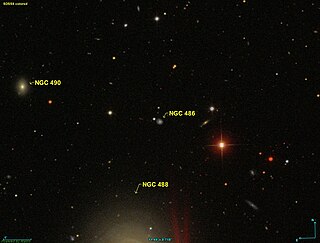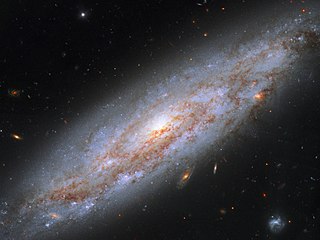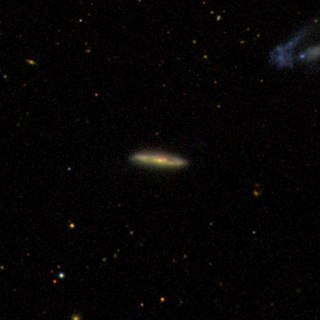Messier 102 is a galaxy listed in the Messier Catalogue that cannot be unambiguously identified. Its original discoverer Pierre Méchain retracted his discovery two years after publication and said that it was a duplicate observation of Messier 101. Later historical evidence favors that M102 is actually the galaxy NGC 5866, although other galaxies have been suggested as possible identities. The National Aeronautics and Space Administration (NASA) considers it to be the same as NGC 5866.

Bindon Blood Stoney FRS was an Irish engineer who also made some significant contributions to astronomy.

NGC 130 is an unbarred lenticular galaxy. It was discovered on November 4, 1850 by Bindon Stoney, the very same day he discovered NGC 126 and NGC 127. This galaxy belongs in the NGC 128 group of galaxies.

NGC 500(also known as PGC 5013) is a type E-SO lenticular galaxy located in the Pisces constellation. It has an apparent size of .8 by .6 arcminutes and an apparent magnitude of 14.2. It was first discovered in 1850 by Bindon Blood Stoney during his time at Birr Castle in Ireland.

NGC 186 is a barred lenticular galaxy located 3.4 million light-years away in the constellation Pisces. It was discovered by Bindon Blood Stoney in 1852.

NGC 486, also occasionally referred to as LEDA 1281966 or GC 275, is a spiral galaxy in the constellation Pisces. NGC 486 was discovered on December 6, 1850 by Irish engineer Bindon Blood Stoney.

NGC 490, also occasionally referred to as PGC 4973 or GC 277, is a lenticular galaxy in the constellation Pisces. It is located approximately 85 million light-years from Earth and was discovered on December 6, 1850, by Irish engineer Bindon Blood Stoney. Although John Dreyer, creator of the New General Catalogue, credits the discovery to astronomer William Parsons, he notes that many of his claimed discoveries were made by one of his assistants. In the case of NGC 490, the discovery was made by Bindon Stoney, who discovered it along with NGC 486, NGC 492 and NGC 500 during his observation of NGC 488.

NGC 492, also occasionally referred to as PGC 4976 or GC 280, is a barred spiral galaxy in the constellation Pisces. It is located approximately 590 million light-years from Earth and was discovered on December 6, 1850 by Irish engineer Bindon Blood Stoney. Although John Dreyer, creator of the New General Catalogue, credits the discovery to astronomer William Parsons, 3rd Earl of Rosse, he notes that many of his claimed discoveries were made by one of his assistants. In the case of NGC 492, the discovery was made by Bindon Stoney, who discovered it along with NGC 486, NGC 490 and NGC 500 during his observation of NGC 488 using Lord Rosse's 72" telescope.

NGC 496, also occasionally referred to as PGC 5037, UGC 927 or GC 288, is a spiral galaxy in the constellation Pisces. It is located approximately 250 million light-years from the Solar System and was discovered on 12 September, 1784 by astronomer William Herschel.

NGC 5609 is a spiral galaxy located 1.3 billion light-years light-years away from Earth, in the constellation Boötes. It has the largest redshift of any galaxy in the New General Catalogue. Prior to 2023, another spiral galaxy, NGC 1262, had been thought to have a higher redshift. NGC 5609 is the most distant visually observed galaxy in the NGC Catalog and was discovered by astronomer Bindon Blood Stoney on March 1, 1851.

NGC 3972 is a spiral galaxy located in the northern constellation of Ursa Major. It was discovered by William Herschel on April 14, 1789. This galaxy is located 66 million light years away and is receding with a heliocentric radial velocity of 846 km/s. It is a member of the NGC 3992 Group of galaxies.

NGC 709 is a lenticular galaxy located 150 million light-years away in the constellation Andromeda. It was discovered by the Irish engineer and astronomer Bindon Blood Stoney on October 28, 1850 and is a member of the galaxy cluster Abell 262.

NGC 714 is a lenticular galaxy located 190 million light-years away in the constellation Andromeda. The galaxy was discovered by astronomer Bindon Blood Stoney on October 28, 1850 and is a member of Abell 262.

NGC 717 is a lenticular galaxy located 210 million light-years away in the constellation Andromeda. The galaxy was discovered by astronomer Bindon Blood Stoney on October 28, 1850 and is a member of Abell 262.

NGC 970 is an interacting galaxy pair in the constellation Triangulum. It is estimated to be 471 million light-years from the Milky Way and has a diameter of approximately 100,000 ly. The object was discovered on September 14, 1850, by Bindon Blood Stoney.

NGC 3005 is an edge-on spiral galaxy in the constellation of Ursa Major, discovered by Bindon Stoney on January 25, 1851. It is a member of the NGC 2998 group, which also includes NGC 2998, NGC 3002, NGC 3006, NGC 3008, and a few others.

NGC 3006 is an edge-on spiral galaxy in the constellation Ursa Major. It has an apparent magnitude of 15. It was discovered by the astronomer Bindon Stoney on January 25, 1851.

NGC 5455 is an emission nebula located in Messier 101 towards the constellation Ursa Major. Eight other regions of Messier 101 are listed in the New General Catalogue, namely NGC 5447, NGC 5449, NGC 5450, NGC 5451, NGC 5453, NGC 5458, NGC 5461 and NGC 5462. Three of these regions were discovered by William Herschel and the other six by Bindon Stoney.

NGC 5461 is an emission nebula located in Messier 101 towards the constellation Ursa Major. Eight other regions of Messier 101 are listed in the New General Catalogue, namely NGC 5447, NGC 5449, NGC 5450, NGC 5451, NGC 5453, NGC 5458, NGC 5461 and NGC 5462. Three of these regions were discovered by William Herschel and the other six by Bindon Stoney.

NGC 5471 is an emission nebula located in Messier 101 towards the constellation Ursa Major. Eight other regions of Messier 101 are listed in the New General Catalogue, namely NGC 5447, NGC 5449, NGC 5450, NGC 5451, NGC 5453, NGC 5458, NGC 5461 and NGC 5462. Three of these regions were discovered by William Herschel and the other six by Bindon Stoney.



















